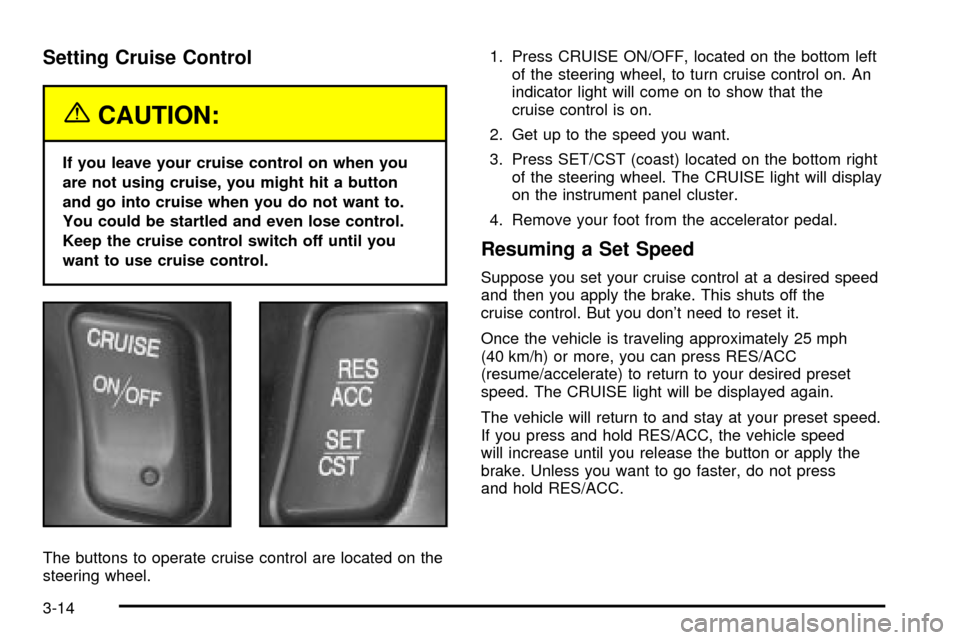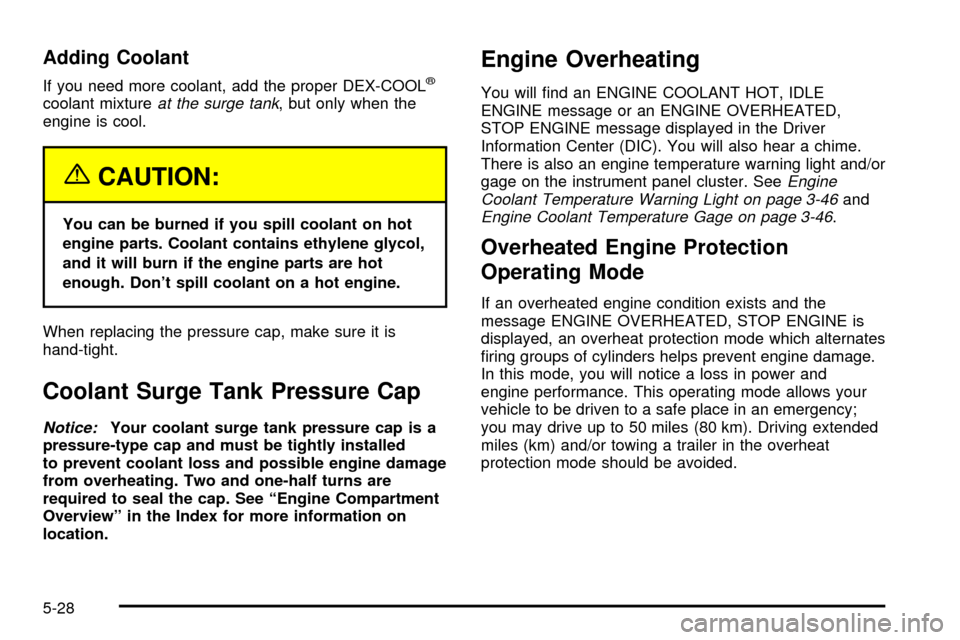2003 CADILLAC SEVILLE instrument cluster
[x] Cancel search: instrument clusterPage 126 of 408

Setting Cruise Control
{CAUTION:
If you leave your cruise control on when you
are not using cruise, you might hit a button
and go into cruise when you do not want to.
You could be startled and even lose control.
Keep the cruise control switch off until you
want to use cruise control.
The buttons to operate cruise control are located on the
steering wheel.1. Press CRUISE ON/OFF, located on the bottom left
of the steering wheel, to turn cruise control on. An
indicator light will come on to show that the
cruise control is on.
2. Get up to the speed you want.
3. Press SET/CST (coast) located on the bottom right
of the steering wheel. The CRUISE light will display
on the instrument panel cluster.
4. Remove your foot from the accelerator pedal.
Resuming a Set Speed
Suppose you set your cruise control at a desired speed
and then you apply the brake. This shuts off the
cruise control. But you don't need to reset it.
Once the vehicle is traveling approximately 25 mph
(40 km/h) or more, you can press RES/ACC
(resume/accelerate) to return to your desired preset
speed. The CRUISE light will be displayed again.
The vehicle will return to and stay at your preset speed.
If you press and hold RES/ACC, the vehicle speed
will increase until you release the button or apply the
brake. Unless you want to go faster, do not press
and hold RES/ACC.
3-14
Page 130 of 408

When the Twilight Sentinelžlever is on and it's bright
enough outside, the regular lamps will go off, and
the high-beam headlamps at reduced brightness will
take over. If you start your vehicle in a dark garage, the
automatic headlamp system will come on immediately.
Once you leave the garage, it will take approximately
one minute for the automatic headlamp system to
change to DRL if it is light outside. During that delay,
your instrument panel cluster may not be as bright
as usual. Make sure your instrument panel brightness
knob is in the full bright position. See ªInstrument Panel
Brightnessº under
Interior Lamps on page 3-21.
If it's dark enough outside and the Twilight Sentinel
ž
lever is off, a HEADLAMPS SUGGESTED message will
display on the Driver's Information Center (DIC). This
message informs the driver that turning on the exterior
lamps is recommended even though the DRL are
still illuminated. Turning on the Twilight Sentinel
žor the
headlamps will deactivate the DRL and remove the
HEADLAMPS SUGGESTED message. If the parking
lamps or the fog lamps were turned on instead, the DRL
will still deactivate and the HEADLAMPS SUGGESTED
message will continue to be displayed.
To idle your vehicle with the DRL off at night, turn off
the Twilight Sentinel
žand shift the transaxle into
PARK (P). Placing your vehicle in PARK (P) disables
the DRL. The DRL will stay off until you shift out
of PARK (P).To drive your vehicle with the DRL off, turn off the
Twilight Sentinel
žand manually turn on the parking
lamps or fog lamps.
As with any vehicle, you should turn on the regular
headlamp system when you need it.
Fog Lamps
Use the fog lamps for better vision in foggy or misty
conditions.
-(Fog Lamps):Press the button with this symbol on
it, located next to the exterior lamp control, to turn the
fog lamps on.
When the ignition is on and you press the fog lamp
button, a small indicator light in the fog lamp button, the
LIGHTS ON and fog lamp indicator lights on the
instrument panel cluster will come on to indicate that the
fog and the parking lamps are on.
Press the fog lamp button again to turn off the
fog lamps.
If you turn on the high-beam headlamps, the fog lamps
will turn off. They'll turn back on again when you
switch to low-beam headlamps.
When the Twilight Sentinel
žis on and the fog lamps are
turned on, the fog lamps, headlamps and parking
lamps will remain on.
The ignition must be on for the fog lamps to operate.
3-18
Page 150 of 408

Instrument Panel Cluster
The instrument panel cluster is designed to let you know at a glance how your vehicle is running. You'll know how
fast you're going, how much fuel you're using and many of the other things you'll need to know to drive safely
and economically.
United States version shown, Canada similar
3-38
Page 165 of 408

Driver Information Center (DIC)
This display gives you the status of many of your
vehicle's systems. The DIC is also used to display driver
personalization features and warning/status messages.
All messages will appear in the DIC display, located
at the bottom of the instrument panel cluster.
DIC Controls and Displays
The Driver Information Center (DIC) buttons are located
to the right of the steering wheel on the instrument
panel, near the air outlets.
«INFOª(Information):Pressing this button up or
down will display the OUTSIDE TEMP, MILES RANGE,
MPG AVG, MPG INST, GAL FUEL USED, AVG
MPH, TIMER, BATTERY VOLTS, LF-RF-LR-RR TIRE
(If Equipped), ENGINE OIL LIFE, TRANS FLUID
LIFE, PHONE (Option) and FEATURE PROGRAMMING
and Blank Display.
INFO (Information) RESET:Pressing this button will
reset the MPG AVG, GAL FUEL USED, AVG MPH,
TIMER, ENGINE OIL LIFE and TRANS FLUID LIFE. For
more information about the trip odometer, see
Speedometer and Odometer on page 3-39.
·MPG AVG (Average Miles per Gallon):This
message shows the approximate fuel economy you
have averaged since the last time you reset the
value. To reset the MPG AVG (Average Fuel
Economy), press the INFO button to display the
MPG AVG then press and hold the INFO RESET
button until 0.0 MPG AVG is displayed.
·GAL (Gallons) FUEL USED:This message shows
how much fuel has been used since the last reset.
To learn how much fuel is used from a new
starting point, press the RESET button while the
GAL FUEL USED is displayed in the DIC.
3-53
Page 273 of 408

A. Windshield Washer Fluid Reservoir. SeeWindshield
Washer Fluid on page 5-39.
B. Underhood Fuse Block. See ªUnderhood Fuse
Blockº
Fuses and Circuit Breakers on page 5-93.
C. Power Steering Fluid Reservoir. See
Power Steering
Fluid on page 5-38.
D. Engine Oil Fill Location. See
Engine Oil on
page 5-13.
E. Engine Oil Dipstick. See
Engine Oil on page 5-13.
F. Brake Master Cylinder Reservoir. See
Brakes
on page 5-40.
G. Transaxle Fluid Cap and Dipstick. See
Automatic
Transaxle Fluid on page 5-21.
H. Engine Air Cleaner/Filter. See
Engine Air
Cleaner/Filter on page 5-19.
I. Engine Coolant Surge Tank and Pressure Cap. See
Coolant Surge Tank Pressure Cap on page 5-28andCooling System on page 5-31.
Engine Oil
If the CHECK OIL LEVEL message appears on the
instrument cluster, it means you need to check
your engine oil level right away. For more information,
see ªCHECK OIL LEVELº under
DIC Warnings and
Messages on page 3-56.
You should check your engine oil level regularly; this is
an added reminder.
5-13
Page 288 of 408

Adding Coolant
If you need more coolant, add the proper DEX-COOLž
coolant mixtureat the surge tank, but only when the
engine is cool.
{CAUTION:
You can be burned if you spill coolant on hot
engine parts. Coolant contains ethylene glycol,
and it will burn if the engine parts are hot
enough. Don't spill coolant on a hot engine.
When replacing the pressure cap, make sure it is
hand-tight.
Coolant Surge Tank Pressure Cap
Notice:Your coolant surge tank pressure cap is a
pressure-type cap and must be tightly installed
to prevent coolant loss and possible engine damage
from overheating. Two and one-half turns are
required to seal the cap. See ªEngine Compartment
Overviewº in the Index for more information on
location.
Engine Overheating
You will ®nd an ENGINE COOLANT HOT, IDLE
ENGINE message or an ENGINE OVERHEATED,
STOP ENGINE message displayed in the Driver
Information Center (DIC). You will also hear a chime.
There is also an engine temperature warning light and/or
gage on the instrument panel cluster. See
Engine
Coolant Temperature Warning Light on page 3-46andEngine Coolant Temperature Gage on page 3-46.
Overheated Engine Protection
Operating Mode
If an overheated engine condition exists and the
message ENGINE OVERHEATED, STOP ENGINE is
displayed, an overheat protection mode which alternates
®ring groups of cylinders helps prevent engine damage.
In this mode, you will notice a loss in power and
engine performance. This operating mode allows your
vehicle to be driven to a safe place in an emergency;
you may drive up to 50 miles (80 km). Driving extended
miles (km) and/or towing a trailer in the overheat
protection mode should be avoided.
5-28
Page 400 of 408

Instrument Panel.............................................3-38
Cluster.......................................................3-38
Overview..................................................... 3-4
Interior Lamps Control.....................................3-21
Interior Lamps................................................3-21
J
Jump Starting.................................................5-45
K
Key in Recall Memory.....................................3-65
Key Lock Cylinders Service..............................6-10
Keyless Entry System....................................... 2-5
Keys............................................................... 2-3
L
Lamps On Reminder.......................................3-17
Lamps...........................................................3-16
Exterior......................................................3-16
Interior.......................................................3-21
Lap-Shoulder Belt...................................1-12, 1-20
LATCH System...............................................1-36
Child Restraints...........................................1-36LATCH System (cont.)
Securing a Child Restraint Designed for the
LATCH System........................................1-38
Leaving Your Vehicle With the Engine Running . . . 2-33
Leaving Your Vehicle.......................................2-11
Lighted Visor Vanity Mirrors..............................2-18
Light.............................................................3-42
Air Bag Readiness.......................................3-42
Anti-Lock Brake System Warning...................3-44
Brake System Warning and Parking Brake
Indicator.................................................3-43
Charging System.........................................3-43
Cruise Control.............................................3-51
Engine Coolant Temperature Warning.............3-46
Fog Lamp..................................................3-51
Lights On Reminder.....................................3-51
Malfunction Indicator....................................3-47
Oil Pressure...............................................3-50
Safety Belt Reminder...................................3-41
Security.....................................................3-51
TCS Warning Light......................................3-45
Traction Control System (TCS) Warning..........3-45
Lights Flash at Lock........................................3-68
Lights Flash at Unlock.....................................3-68
Loading Your Vehicle.......................................4-33
Lockout Protection..........................................2-11
Locks............................................................2-10
Central Door Unlocking System.....................2-10
Door........................................................... 2-9
8